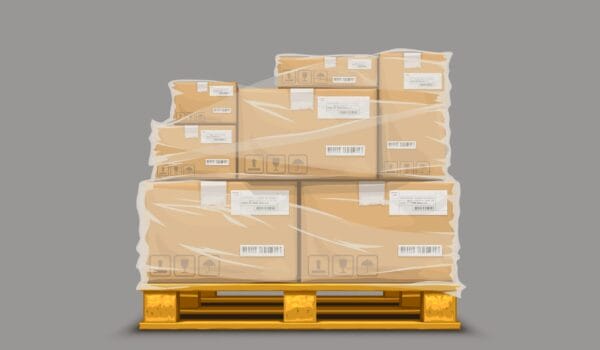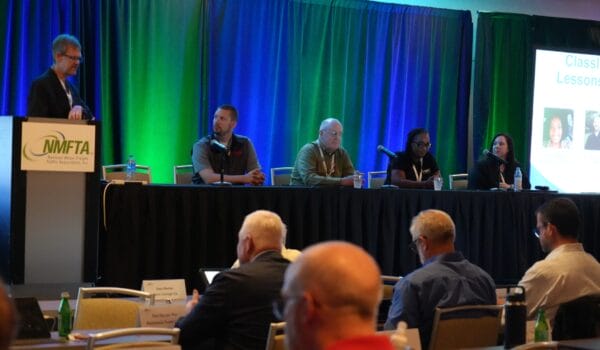Packaging freight for less-than-truckload (LTL) shipping can be as simple as a six-sided container, or as complicated as some of the newer technology that will “think” as it interacts with the freight itself.
A crate is still a crate, of course. It’s a simple framework made of wood, metal, or wire – with diagonal, horizontal, and vertical elements that don’t allow any part of the freight to protrude from the enclosure.
Crates and boxes will always be part of the LTL packaging picture, no matter how advanced the accompanying technology gets. But note, the whole field is getting quite advanced, which is why the term “smart packaging” is becoming more widely used.
New Technology
New packaging technologies have manifestations that are both intelligent and active. Intelligent packaging technology uses innovations like radio-frequency identification (RFID) to track shipments or time temperature indicators (TTIs) to determine if the products were exposed to excessive temperatures and for how long. Active packaging is often used for the shipping of foodstuffs and has the ability to extend the shelf life of products by maintaining atmospheric conditions or controlling moisture levels, for example.
All of it comes into play as shippers and carriers deal with the unique realities of shipping in the LTL environment. Consider the reality: LTL carriers are hauling trailers with a wide variety of items, and there could be many reasons to expect they won’t all sit peacefully in place.
Trucks often stop abruptly or accelerate suddenly. Roads are not always smooth, which can cause freight to bounce up and down. Even the simple dynamic of the truck going down the road can cause vibration that brings about movement of the items in the trailer.
Packaging Qualms
So when packaging freight, Larissa Franklin, a packaging expert at the National Motor Freight Traffic Association, Inc. (NMFTA)™, wants shippers to consider some potential issues.
For example:
Freight can be at risk when it’s stored adjacent to certain other kinds of freight.
“If you have a box next to a sharp piece of machinery, it might be moving across the road and there’s a shifting,” she shared. “It’s possible that if you don’t have a box that’s thick enough or has a high enough puncture resistance, the piece of machinery could go through the box and damage the boxed freight.”
Freight can also be at risk as a result of being bottom-loaded.
“Bottom-loaded freight needs to be strong enough to hold significantly heavy weight,” said Franklin. “These pallets often weigh up to 5,000 pounds, and if you have a pallet of boxes that’s unable to withstand such crush forces, the carrier must be aware of that. It’s important to realize there is heavy freight moving, and to make sure the packaging is sturdy enough to withstand the force.”
Best Practices
NMFTA member Averitt offers some tips on sound stacking:
Boxes should be stacked squarely on the pallet – lined up corner-to-corner with no overhang.
It’s fine to stack near the edges, but under no circumstances should boxes extend over the edge. Overhang not only makes cartons vulnerable to damage, it also decreases their strength by as much as one third.
Don’t use an interlocking pattern, as this can further weaken the cardboard. Distribute the weight evenly and do your best to make sure the top surface is flat.
To find and deploy the right kind of packaging for every type of product, as well as to take into account the potential perils of the LTL shipping environment, Franklin urges shippers to pay meticulous attention to the National Motor Freight Classification (NMFC)®’s requirements.
As an example, the NMFC’s Item 222 series enumerate the requirements for fiberboard boxes, including size and weight limits, the strength of the fiberboard used and the box manufacturer’s certificate that must appear on all conforming boxes.
Meanwhile, Item (Rule) 245 provides the construction requirements for wood and metal crates.
Averitt also offers some useful thoughts on crating:
Crates must also be built so that slats are close enough to protect the contents and prevent any items from protruding outward. Additionally, a crate must include three-way locking corners that are joined by nails or fasteners.
Strengthening your crates with additional supports will further protect your shipment from damage. For example, two diagonal boards on each side can make a crate nearly 12 times stronger than a non-reinforced crate.
Performance Plus Global Logistics urges shippers and carriers to give careful consideration to whether pallets or crates provide the best option in a given LTL shipping situation:
Wooden pallets are recommended for most shipments regardless of whether the shipment is fragile or not. Carriers prefer and recommend using pallets even when it is a single cardboard box being shipped.
Wooden pallets are preferred for freight shipping over pallets made of plastic or other materials. The reason is that these other materials often break and allow shipments to move during transit.
Wooden crates are best used to help organize and protect your freight. Separate fragile and non-fragile items into their own crates to avoid parts of your shipment hitting or scratching each other during transit. Fragile items are best wrapped in a protective material like bubble wrap. Fill each crate to the top, leaving no room for movement.
While pallets and crates will protect your shipment, there is supplementary equipment that can help keep your freight in place and save it from moving around while in transit. Cardboard boxes and sheets can help cushion any area where your freight may bump into other objects. You can also use banding to further tighten your shipment if it still moves under the shrink wrap.
Education and Optimization Awaits
Shippers who want to ensure the safe transport and delivery of their freight via LTL carriers are urged to consistently consult the NMFC and its digital equivalent ClassIT®. There is no more comprehensive resource to help shippers and carriers navigate the potential perils of LTL shipping and ensure that they deploy the most effective packaging to protect their freight. Should shippers have issues with damage, they can use one of the FCDC’s registered packaging labs to help find optimal packaging methods to better protect their freight.
To access further education and training concerning packaging, visit our education and training page, or contact us at customerservice@nmfta.org.
NMFTA is offering its highly-popular NMFC Packaging Webinar Series in 2024 beginning May 14 as well as Nov. 12. Learn more and make plans to attend these insightful sessions.







